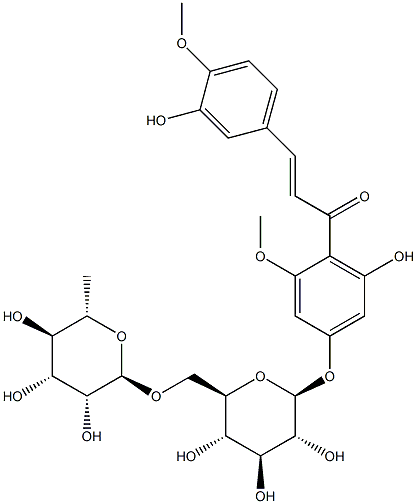All AbMole products are for research use only, cannot be used for human consumption.

Methyl hesperidin could quench the intrinsic fluorescence of BSA and the quenching mechanism should be a combined quenching process. Hesperidin, hesperidin methyl chalone and phellopterin reduce TNF-alpha-induced VCAM-1 expression through regulation of the Akt and PKC pathway, which contributes to inhibit the adhesion of monocytes to endothelium. Methylhesperidin exerts no obvious toxic effects in mice of either sex when administered at a level as high as 5.0% in the diet. Methyl hesperidin lacked any carcinogenicity for B6C3F1 mice in the 96-wk feeding regimen used in a study.
| Molecular Weight | 624.59 |
| Formula | C29H36O15 |
| CAS Number | 11013-97-1 |
| Form | Solid |
| Solubility (25°C) | Water |
| Storage | 4°C, protect from light |
[2] Kawabe M, et al. Toxicol Lett. Subchronic toxicity study of methyl hesperidin in mice.
[3] Kurata Y, et al. Food Chem Toxicol. Carcinogenicity study of methyl hesperidin in B6C3F1 mice.
| Related Products |
|---|
| 7-Deoxyloganin
7-Deoxyloganin is a biosynthetic precursor of Loganin. 7-Deoxyloganin undergoes hydroxylation catalyzed by 7-deoxyloganin 7-hydroxylase, a cytochrome P450-dependent monooxygenase, to produce Loganin. |
| Mannose-BSA
Mannose-BSA is an important organic intermediate that combines the properties of mannose and bovine serum albumin, which is of unique value in the field of scientific research, and can be used as a key substance in a variety of organic synthesis reactions. Mannose is an important monosaccharide that binds specifically to mannose receptors (e.g., CD206 receptors on dendritic cells and macrophages), and therefore has a wide range of applications in immunomodulation and targeted drug delivery. BSA is a protein carrier that is commonly used for biocoupling, and its abundant surface amino groups can covalently bind to mannose to form a mannose-BSA complex. |
| Sulfo-NHS-Biotin
Sulfo-NHS-Biotin stongly label single SDS-2ME soluble cuticular protein. |
| GAPDH-IN-1
GAPDH-IN-1 (GAPDH Inhibitor Compound F8) is a covalent inhibitor of GAPDH (IC50 = 39.31 µM). It viability of, and glucose metabolism in, HEK293 cells in a concentration-dependent manner. |
| O-acetylcamptothecin
O-acetylcamptothecin is a derivative of camptothecin, a naturally occurring alkaloid extracted from the bark of the Chinese tree Camptotheca acuminata. Camptothecin and its derivatives are primarily known for their potent anticancer properties, particularly through their action as inhibitors of topoisomerase I, an enzyme critical for DNA replication and transcription. |
All AbMole products are for research use only, cannot be used for human consumption or veterinary use. We do not provide products or services to individuals. Please comply with the intended use and do not use AbMole products for any other purpose.


Products are for research use only. Not for human use. We do not sell to patients.
© Copyright 2010-2024 AbMole BioScience. All Rights Reserved.
